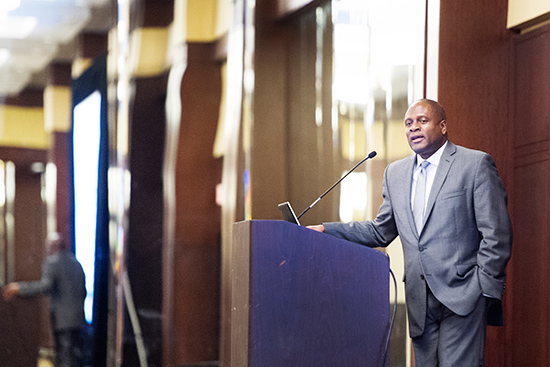National AIDS Policy Director Urges Collaboration on HIV/AIDS
SSW alum keynote speaker at addiction conference in Boston
 Douglas Brooks (SSW’99) encouraged attendees at last week’s Addiction Health Services Research Conference, sponsored by Boston University, to think of new ways to identify, screen, and attain care for people living with HIV. Photo by Jackie Ricciardi.
Douglas Brooks (SSW’99) encouraged attendees at last week’s Addiction Health Services Research Conference, sponsored by Boston University, to think of new ways to identify, screen, and attain care for people living with HIV. Photo by Jackie Ricciardi.
Lena Lundgren felt like a “proud mama,” she said when introducing Douglas Brooks as the keynote speaker at last week’s Addiction Health Services Research Conference in Boston.
Last March, President Barack Obama appointed Brooks (SSW’99) director of the Office of National AIDS Policy (ONAP), which manages the US response to the AIDS epidemic. Prior to that, Brooks was a member of the Presidential Advisory Council on HIV/AIDS. And he spent 16 years at the Justice Resource Institute in Boston, where he rose from an intern to senior vice president for community, health, and public policy, serving a diverse population of people living with HIV/AIDS. Brooks is the first HIV-positive African American to lead the national office.
“There could not have been a better choice” than Brooks to lead ONAP, said Lundgren, a School of Social Work professor of welfare policy and associate dean of research.
In many ways, Brooks’ homecoming represents something of a high-water mark for SSW. His White House appointment makes him one of the most visible alumni working on the national level. At the same time, Lundgren, who is also director of the Center for Addictions Research & Services, became the first social worker to host the annual Addiction Health Services Research (AHSR) Conference, which drew hundreds of attendees from around the country to Boston last week. Richard Saitz (CAS’87, MED’87), a School of Medicine professor of medicine, a School of Public Health professor of epidemiology, and associate director of the Office of Clinical Research, and Jeffrey Samet (SPH’92), a MED professor of medicine, an SPH professor of community health sciences, and chief of the section of general internal medicine at Boston Medical Center, helped organize the conference. With its focus on integrating addiction, mental health, and medical care services, the conference also addressed a core mission of SSW’s new endowed Center for Innovation in Social Work and Health.
Brooks’ presentation, Addressing HIV Infection in Efforts to Coordinate Medical and Addiction Care, tied in several themes discussed among the 300 attendees of the three-day conference, where social workers and researchers mixed with public health and medical professionals.
The president is “100 percent committed to HIV” and since taking office has established a three-pronged National HIV/AIDS Strategy, Brooks said, to decrease the number of new infections, increase access to health care for those living with HIV, and reduce HIV-related health disparities. He said his task is to implement these goals and the HIV/AIDS Care Continuum initiative.
He cited some troubling statistics in the nation’s war on AIDS. There are currently 1.1 million people living with HIV in the United States, and new infections number 50,000 each year, according to the Centers for Disease Control and Prevention. Roughly 64 percent of new infections occur among gay men, bisexuals, and men who have sex with men. While new infections have dropped by 20 percent among women and by 22 percent among injectable drug users, young gay black men have seen an alarming 48 percent increase.
Among women living with HIV in the United States, one-third suffer from post-traumatic stress disorder, Brooks noted. Roughly 55 percent have encountered intimate partner violence, and woman experiencing domestic violence have double the risk of dying from HIV. And black women die from the disease in greater numbers than any other sector of the population.
Just two decades ago, thousands of babies were born with HIV. But now that a growing number of HIV-positive women are linked to treatment and taking antiretroviral drugs, only 30 babies were born with the virus in 2010, Brooks said. While the vast majority of people living with HIV in the United States have been diagnosed, an estimated 183,000 people remain unaware of their condition, he said. This smaller, yet significant, group of people needs to be identified and connected with care.
“If we know they’re out there, we need to find ’em,” Brooks said, adding that those living with HIV often experience mental health or substance abuse problems and his office is open to finding new ways to collaborate across the health fields to screen for the undiagnosed.
One conference attendee asked Brooks about the administration’s plans for dealing with rates of HIV infection among people in the criminal justice system, which he claimed were up to four times higher than in the general population.
The government has “been doing a fairly good job of treating people in the system,” Brooks said. “Transition outside of prison is where we have to do a much better job.” He also said that some of those released might be among the 183,000 people living undiagnosed.
Another attendee wanted to know if there were certain characteristics that defined this population.
“I wanted to end this with some profound thing,” Brooks answered. But what he replied—“I don’t know. We don’t know.”—drew a laugh from the crowd.
– Author, Leslie Friday can be reached at lfriday@bu.edu; follow her on Twitter at @lesliefriday.